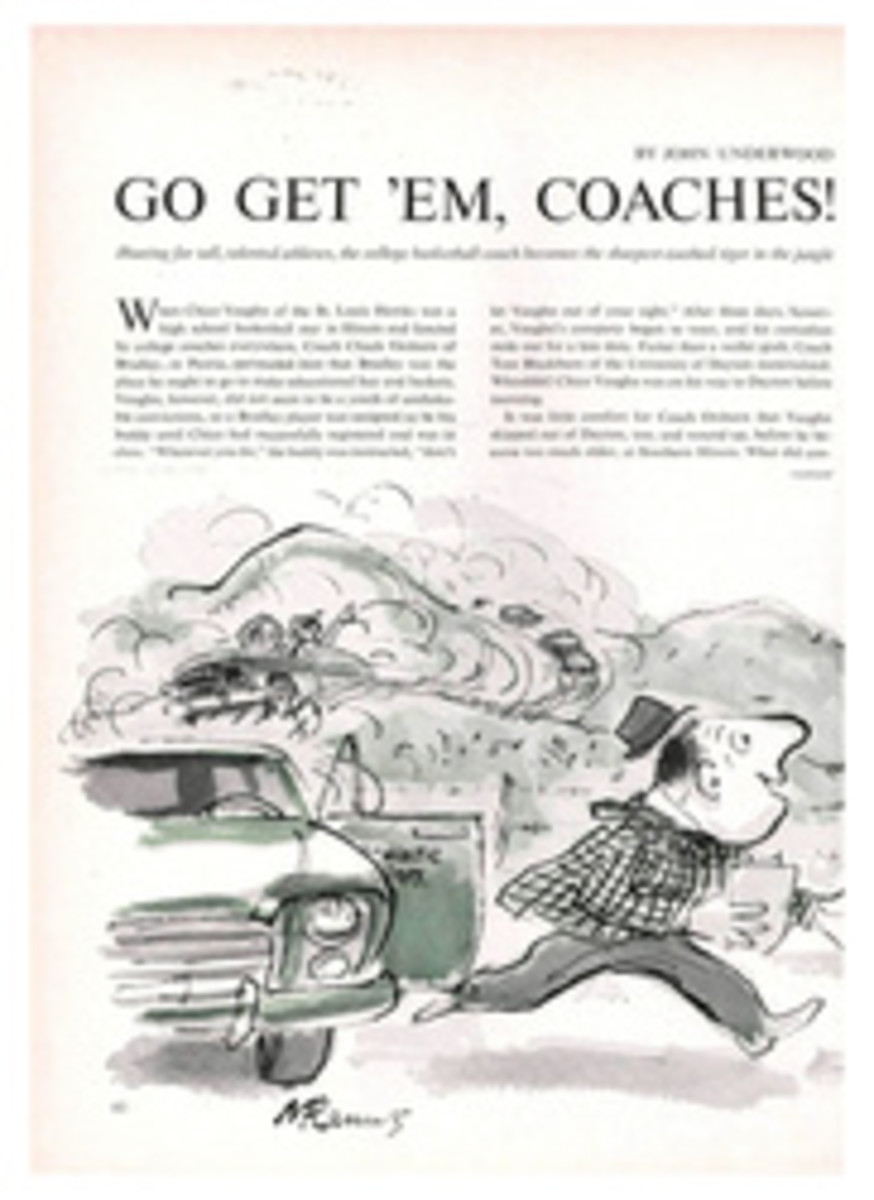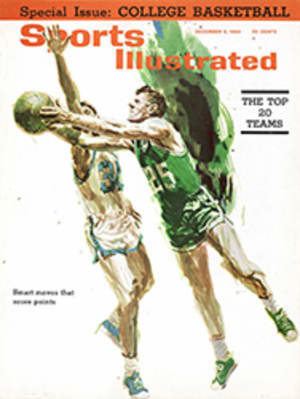
SMART MOVES BY A MASTER OF DECEPTION
Frank Ramsey once was fouled so quickly after coming into a game that his Celtic teammate, Bill Russell, commented, "Frank was still so cold he had to warm up before shooting his free throw." No one has ever been better at the art of suckering an opponent into committing fouls than this former All-America from Kentucky. Ramsey capitalizes on the fact that, by its rules, basketball is a non-body-contact sport. When contact occurs—even accidentally—the chances are a foul will be called. Free throws account for some 20% of points scored, so it obviously is more blessed to be fouled than to foul. While it is both efficient and ethical to lure an opponent into committing a foul, Ramsey takes this strategy even further, into the realm of gamesmanship—which may affront some concepts of fair play but is accepted practice in the most skilled strata of the sport. The spectator's appreciation will be enhanced by Ramsey's revelations on the following pages.
WHY I FALL
Drawing fouls chiefly requires the ability to provide good, heartwarming drama and to direct it to the right audience. I never forget where the referees are when I go into an act. The most reliable eye-catcher is still the pratfall. Particularly on defense, when everything else fails, I fall down. Luckily, I happen to be type-cast for the part, because I have a peculiar running style—back on my heels, with my knees locked. It makes falling very easy and natural-looking for me.
I am beaten here. My man has a clear drive past me to the basket, unless I step in front of him—and that would be a definite blocking foul on me.
Instead, I shift my weight to get as much of my body as I can in front of him without moving my feet. If the official is anywhere behind me, it will appear as if I am in front of my man.
Then, at the first contact, I fall down—as if my man had charged right into me. With any luck, the foul I deserve will be called on the other guy.
A NEW HOOK
The most opportune time to draw a foul is while shooting, particularly the shots in close. A guard or forward must be able to take his man inside, as I have done here, in order to try a hook. But drawing fouls is not just a matter of making points. Getting opposing players in foul trouble will make them extra careful on defense and even force the whole team to change its basic style of play—always an advantage.
The usual way to shoot a hook shot (as I am doing, right) is with your nonshooting arm held up, elbow crooked. This gives you balance and keeps your man away from you. But if I want to draw a free throw, I drop the arm and pull it in to my side (below). This brings my man on top of me and usually provides so much contact that the referee will call a foul.
I TRY FOR THREE
I am not afraid to take chances when I am shooting, because the way the game is played the officials almost always side with the offensive player in a tough judgment situation. When I try to set up a three-point play, the odds are with me.
In this ploy (left), I have faked out my man. He has jumped too soon and come down. He can't possibly block my shot.
But instead of going straight up, I gamble by jumping lightly into him. The brush should not disturb my shooting and may earn me a foul shot as well.
I MOVE TO THE REAR
When I am guarding the player with the ball and contact occurs, I forget pride. I don't hold my position, even if I am sure I am right. But if I forget and do stand my ground, I stand perfectly rigid. Even flinching counts against me.
WRONG: I ought to get this foul (at right). But I should not have moved at all, because that makes it seem as if the defensive player is responsible.
RIGHT: Falling is always safest. Notice that I collapse at the least bit of contact. I react before the offensive man does, so that the blame appears to be his.
BUMP AND SHOOT
This ploy probably was originated by Dolph Schayes. Certainly he always did it better than anyone else. It utilizes reverse psychology on the referee. The man with the ball starts in good position but then creates the foul deliberately by bumping before he shoots. It happens so fast, though, that the officials believe the defensive man must have fouled—on the theory that nobody would be looking for trouble if he is set for a shot. It should be done very subtly, though, so that it does not embarrass an official. I never try to make an official look bad. If I must talk to one, I try to be polite and make him feel I'm on his side. This is an emotional game and the hotheads don't get the breaks.
I have the hall and I'm moving into better position to put up a shot. Suddenly, however, I change my course...
...and bang my shoulder into my guard. I don't try to bull my way in. That would be an obvious charge. I just make contact, then step back quickly.
Then I shoot. Not only do the officials usually call a foul on the defensive man, but the contact helps me brace myself for a good shot.
DEFENSIVE REBOUNDS
Under the basket a good actor has a big advantage. The ball is loose, we're all moving and there is bound to be a lot of contact. Naturally, the officials are looking for fouls, so it's a good time for drawing them. And for my dramatics.
I hold position here, so I have an edge—if the referee suspects afoul, he is more likely to call it against the other man.
From the side you could tell that I'm falling on purpose here. But the official is usually under the basket, right in front of me. If I act pained enough he'll call a push.
OFFENSIVE REBOUNDS
In the situation above I do have position, so unless the ball takes a crazy bounce out of my reach I don't have to worry about overacting. Here, though, I am blocked out, and have a better chance to get the foul than I have to get the ball. Actually, I have nothing to lose in either case. I'm not breaking any rule, so the officials shouldn't call anything on me.
Cut off from the hall, with my opponent all set (left), I just happen to collide with one of his arms. I bounce off in agony (below), pretending he has elbowed me out of the way.
OLD RELIABLE
The underhand shot is still the classic maneuver for drawing a foul. Anytime I am near the basket and am fouled just before I shoot, I flick the ball up as fast as I can. It may look enough like a legitimate shot for me to get two free throws instead of one. All the pros know about this sort of thing. They know what I've been getting away with, without having to see drawings. But it isn't easy to combat these moves when they're done properly.
EIGHTEEN ILLUSTRATIONS
ROBERT HANDVILLE

